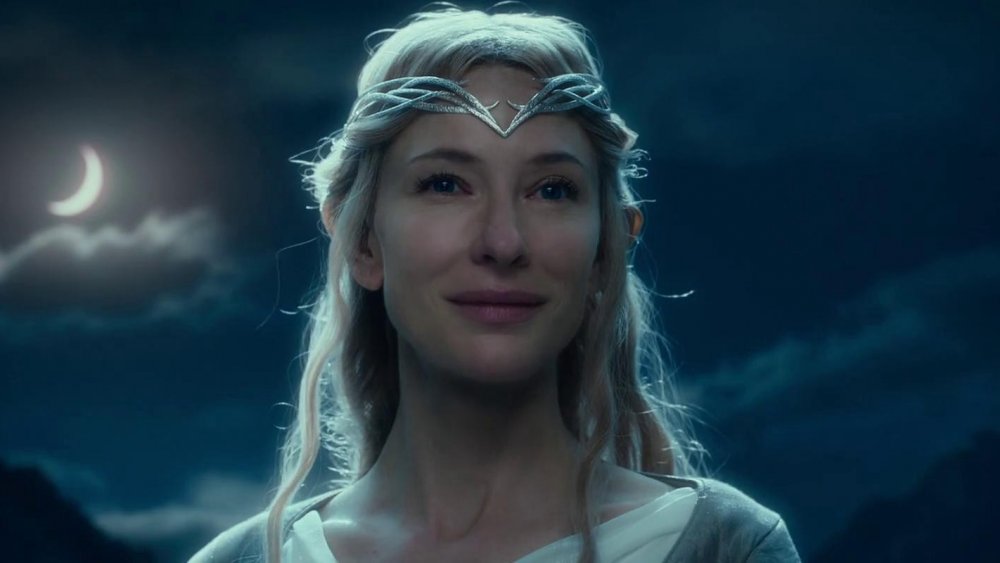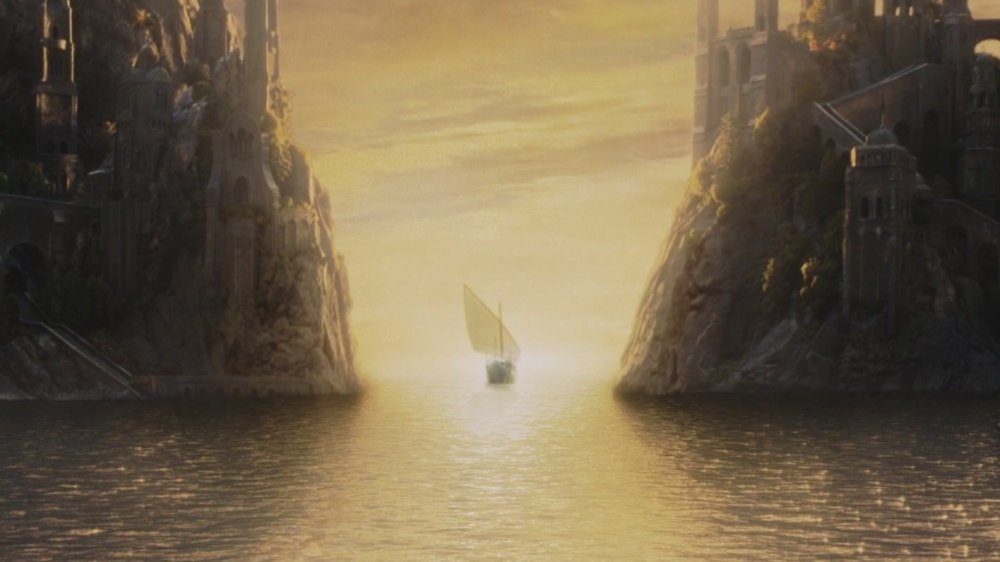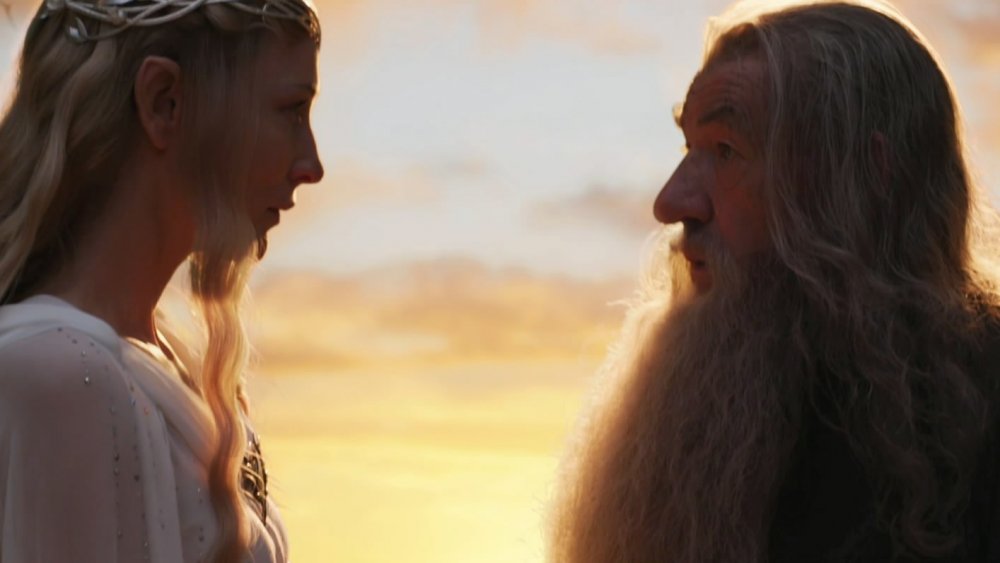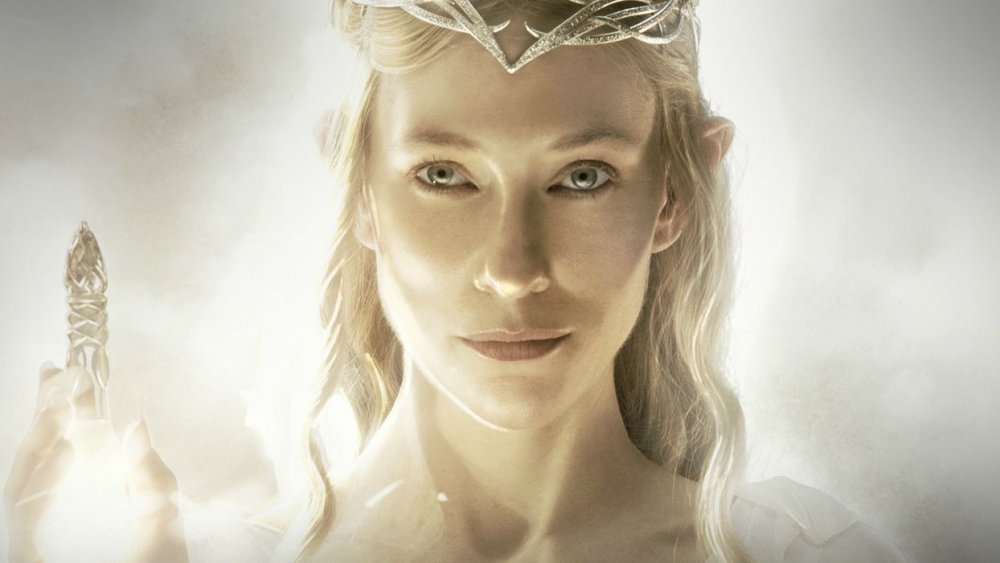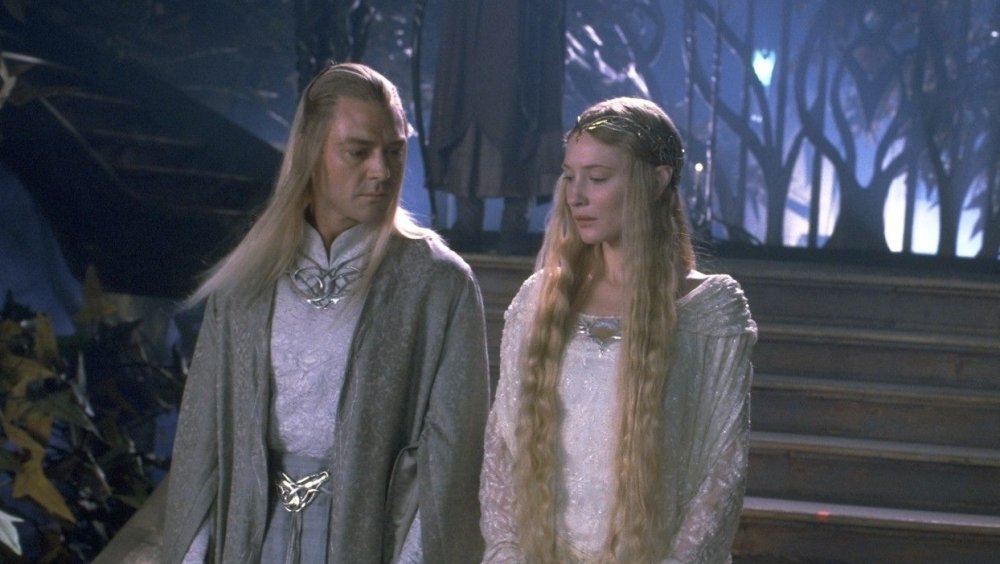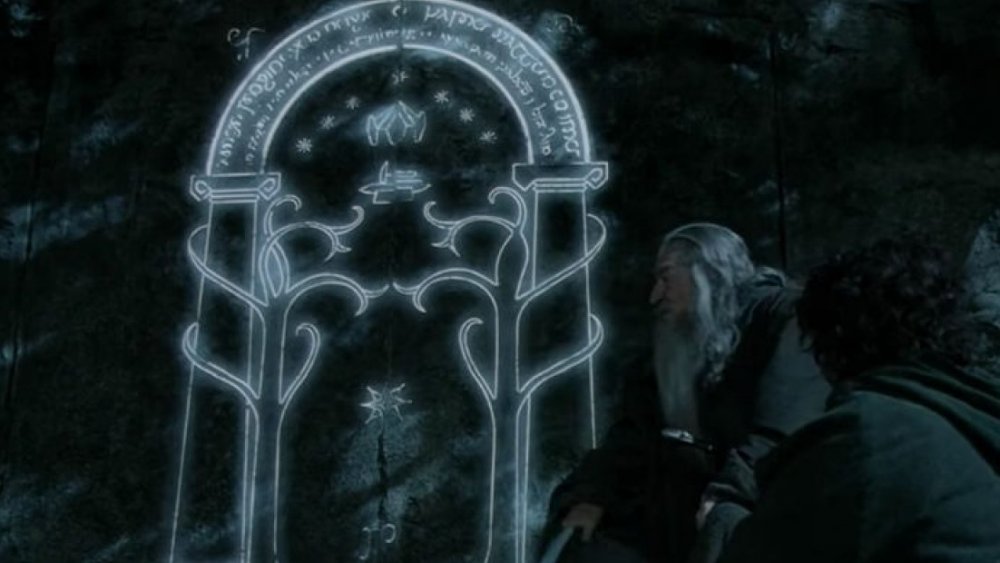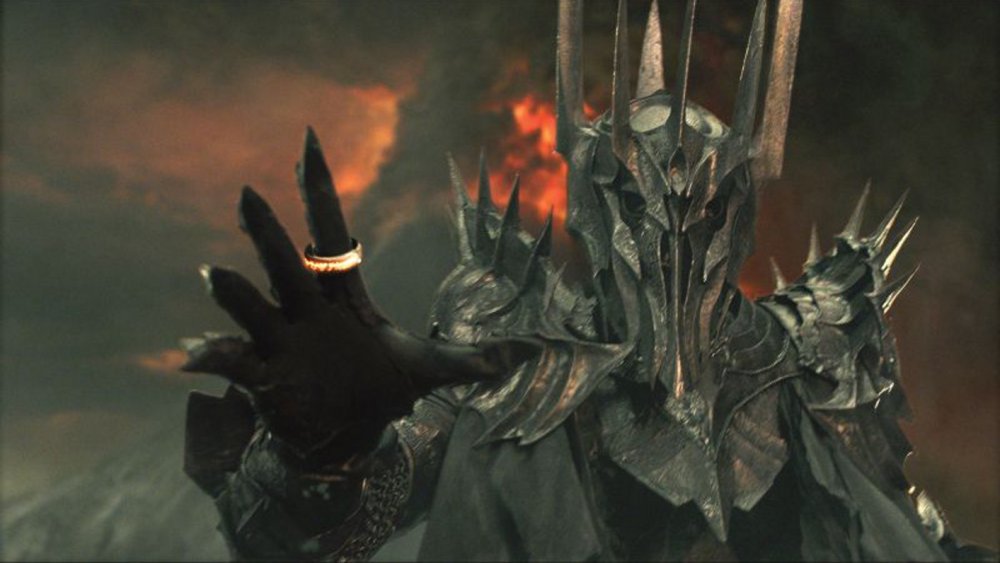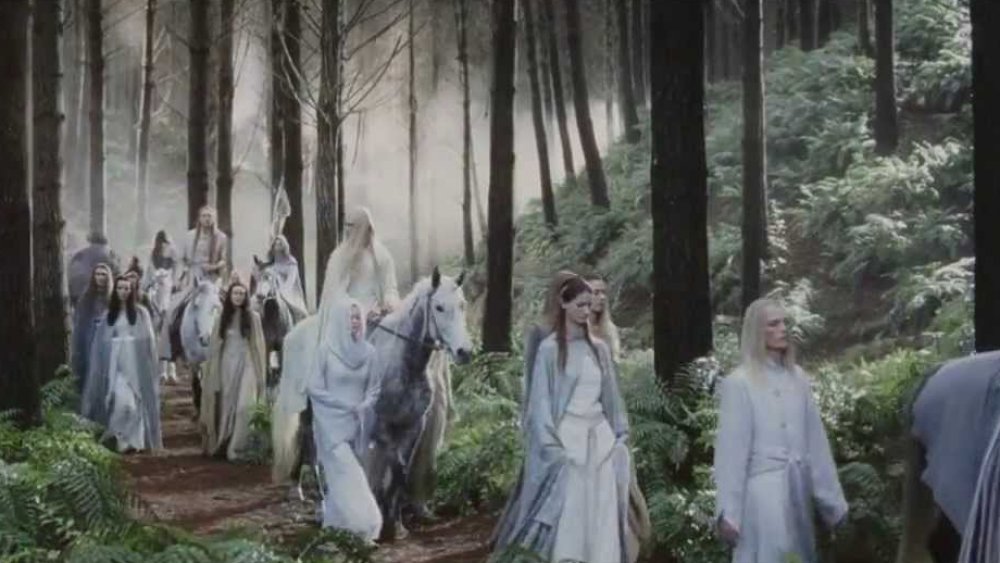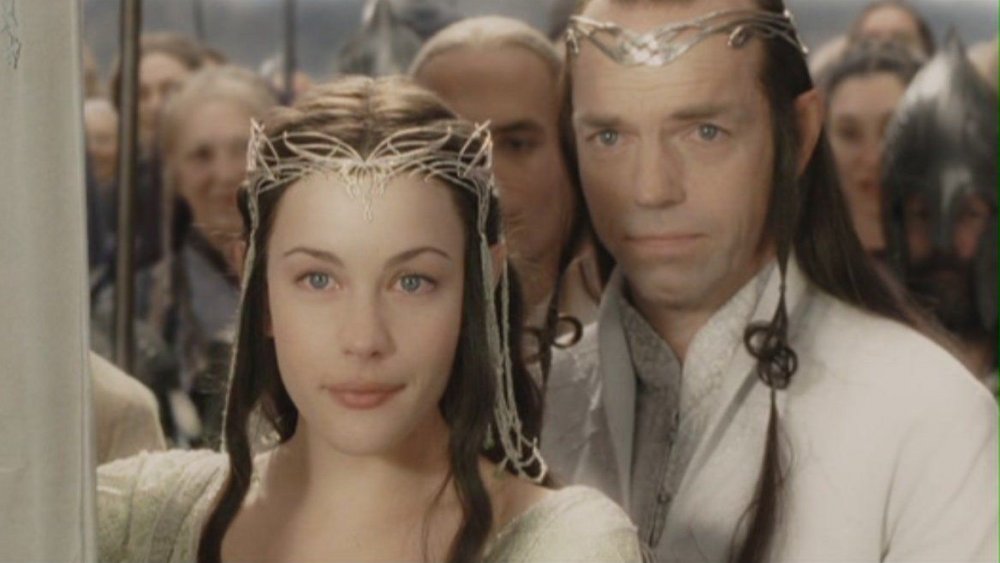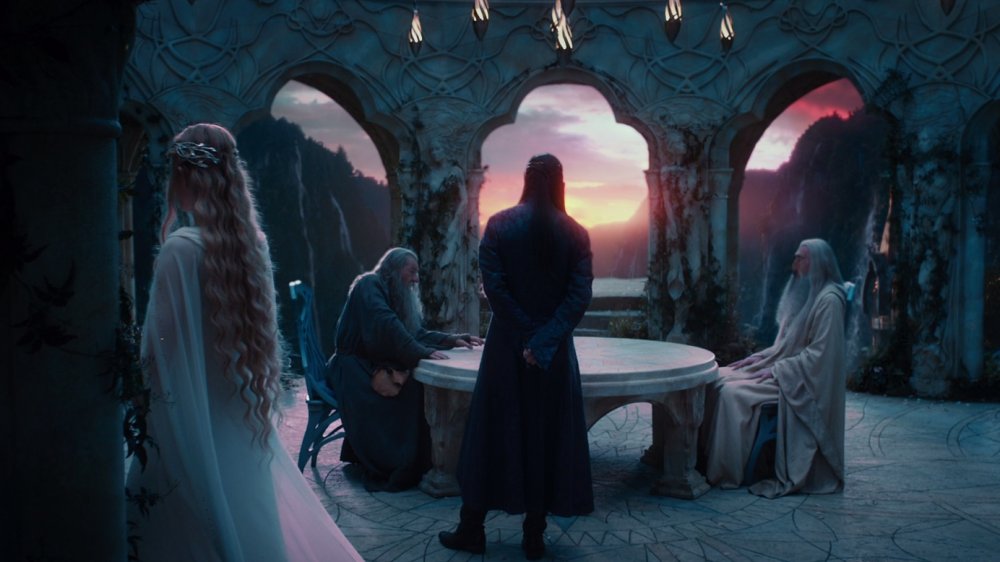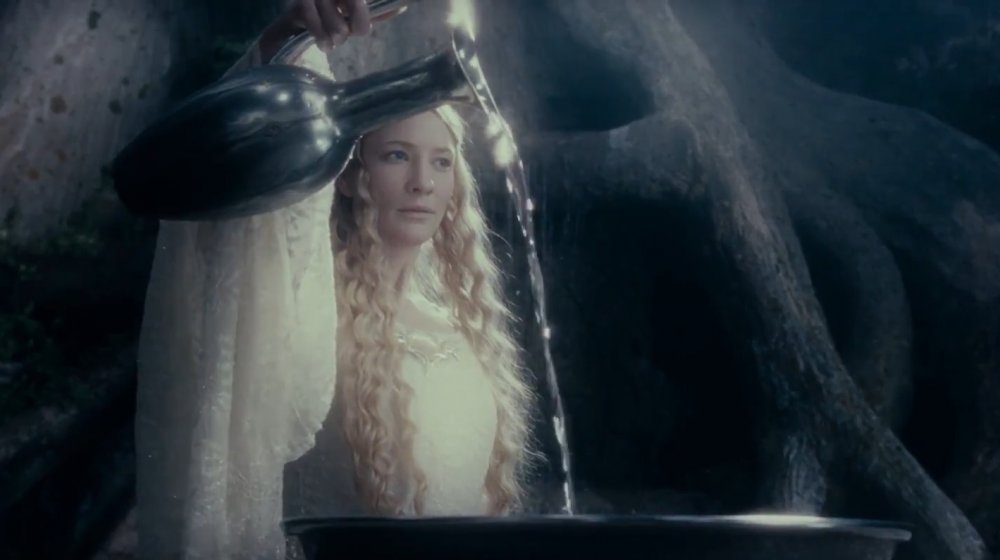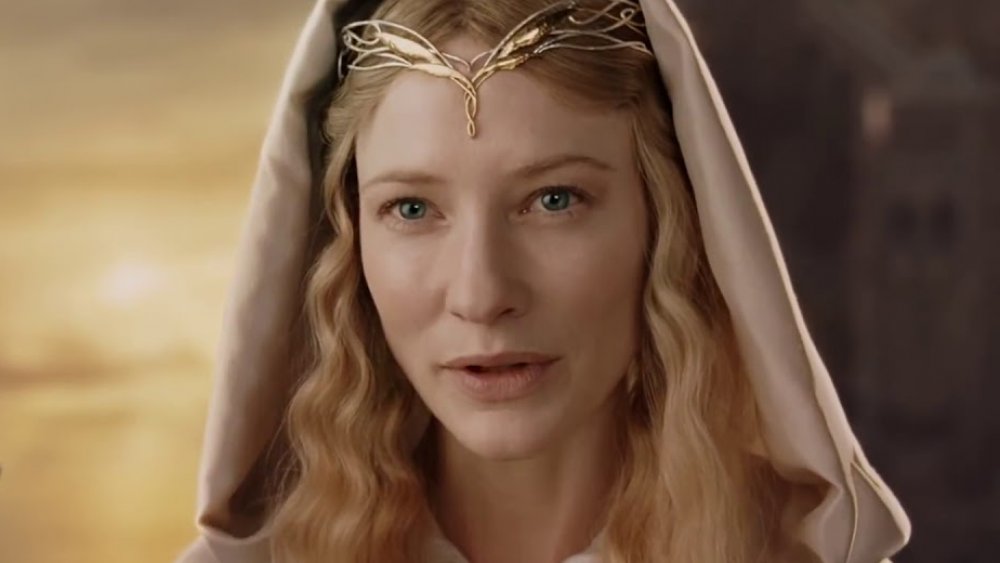Galadriel's Backstory Explained
There aren't a ton of female characters in The Lord of the Rings, but when they do show up, they usually dominate. From Arwen swooping in to save Frodo from the clutches of the Black Riders to Éowyn's "I am no man" line before she takes down the Witch-king, women have certainly left their mark on Middle-earth. For all the heroics, though, there's one woman who stands above the rest, even if she does most of her most important work in the background.
The Lady Galadriel plays a quiet yet critical part in both The Lord of the Rings and The Hobbit stories. Along with her splashier moments — like helping to take down the Necromancer in Mirkwood or aiding the Fellowship of the Ring after their scrape in Moria — she also stays busy orchestrating events in the background. In fact, she ends up being one of the primary opponents to Sauron from the first moment he pops up in the Second Age. Heck, her story goes back even further than that, thousands upon thousands of years back to the First Age and beyond to the earliest days of Middle-earth history.
While Galadriel's story evolved quite a bit over the course of J.R.R. Tolkien's life, and some of the details vary from one source to another, we've done our best to pull everything together into one, coherent narrative that takes a deep dive into the backstory of this elven aristocrat.
Beginnings in the West
Galadriel starts her life way back in the earliest recorded days of elven history. See, when elves first awake in Middle-earth, they're initially led by the Valar — the spirits that guard the world — far into the West, across a sea, to a continent known as the Blessed Realm. This is done to help keep them safe from the Dark Lord Morgoth, who's on the loose and busy corrupting everything he can get his hands on. In fact, one of the origin stories for the orcs — most of which are admittedly rather vague — claims that Morgoth did catch some of these young elves before they migrated west, torturing them and slowly turning them into the first generation of orcs.
Regardless, over time, many of the elves that aren't captured make their slow way across Middle-earth until they arrive at their new home, and it's here, roughly 3,000 years later, that Galadriel is born. For those of you wondering, this makes the Lady of Lórien over 8,000 years old when the events of The Lord of the Rings take place.
Galadriel's blessed youth
In her youth, Galadriel maintains a sensational reputation in the heavenly kingdom. She's born into royalty and is both an impressive loremaster and a gifted athlete. According to the book Unfinished Tales, she's said to be "the tallest of all the women of the Eldar of whom tales tell," and she's recorded to be around 6'4" in height. While her beauty is brought up on multiple occasions, her hair is specifically called out the most often. In The Silmarillion, it's stated that "her hair was lit with gold as though it had caught in a mesh the radiance of Laurelin" — that is, one of the two magic trees that light up the entire Blessed Realm before the sun and moon are created.
Unfinished Tales even suggests that her hair looks like the light of both trees mixed together, and that it inspires the great elven craftsman Fëanor to create the Silmarils, the titular jewels of The Silmarillion. These one-of-a-kind baubles eventually attract the attention of the Dark Lord Morgoth, who eventually destroys the two trees and steals the jewels, sparking a war with the elves in the process.
Joining in a rebellion
Galadriel's impressive pedigree — her dad and one of her brothers, in particular, are both famous kings — makes it difficult for the elven princess to avoid the limelight, and eventually, her lofty position drags her into one of the most infamous events in early Middle-earth history.
When Morgoth steals the Silmarils and destroys the trees of light, it brings the peaceful existence in the Blessed Realm to an abrupt, shadowy halt. Feeling unprotected and betrayed by their Valarin guardians, a large faction of elves decides to reject their apparently lackluster protection, opting to take things into their own hands instead. They chase their enemy back to Middle-earth where he's fled with their priceless gems. A small portion of these elves is made up of fanatical and even recklessly violent members. They seize a fleet of ships, killing their elven guards, and sail back across the sea to the western shores of Middle-earth.
The larger host, with Galadriel in their midst, doesn't participate in the violence. However, stirred by the harrowing events and feeling a powerful calling to return to the lands that they came from, they still attempt to leave the Blessed Realm — though by a less violent path. With no ships left behind and the Blessed Realm at their backs, they head far north to an area called the Helcaraxë.
Galadriel in the First Age
The Helcaraxë is an area where the Blessed Realm and Middle-earth come close together, and there are, as explained in The Silmarillion, "vast fogs and mists of deathly cold, and the sea-streams [are] filled with clashing hills of ice and the grinding of ice deep-sunken." Needless to say, many elves perish in the cruel crossing, but the survivors do reach Middle-earth once again.
Once Galadriel arrives back in Middle-earth, she spends the next several hundred years lying fairly low. We're in the First Age at this point, and there are a ton of epic wars going on as the elves are slowly ground down by Morgoth and eventually bailed out by the Valar, the very guardians that they initially abandoned.
One item of note is that during this time, Galadriel visits the elven kingdom of Doriath. She's with her brother, Finrod, who eventually heads off to found his own kingdom, but Galadriel doesn't go with him. Why? Because it's here that she meets a hunky elven prince named Celeborn. Her future husband's origin is a bit murky, but it appears that he's the grandnephew of the king, and the two fall in love and eventually hook up. She also spends this time in a sort of mentorship with Melian, the powerful queen of Doriath, who teaches her great lore and wisdom. Eventually, the pair of lovebirds pack up and head further east, leaving the politics and family drama behind in search of a peaceful existence deeper in the continent.
Middle-earth migrations
When the First Age ends with the defeat of Morgoth, many of the exiled elves return to the Blessed Realm in the west. However, some of them head further east, where they find Galadriel and Celeborn already settled down, exploring new lands and enjoying the sights. At this point, we're in the beginning of the Second Age, still over 6,000 years from The Lord of the Rings and The Hobbit, which take place at the end of the Third Age.
It's now, with the world resetting after the dark days of Morgoth, that the power couple begins to dabble with legitimate leadership. Initially, though, their leadership résumé ends up being a bit flaky, partly thanks to Tolkien's differing details in each version of the story that he wrote. Galadriel and Celeborn begin by leading two separate elven communities in northwestern Middle-earth. Roughly 750 years into the age, though, they move on from these and head southeast to Eregion, an area ruled by one of Galadriel's distant cousins named Celebrimbor. This is the same region where the Fellowship of the Ring is later tracked by birds and finds the doors of Moria.
From there, Galadriel eventually makes a trip with her daughter, Celebrían, through the dwarven mines and pays her first visit to the elves that live in Lothlorien. Celeborn, who isn't fond of dwarves and doesn't fancy a trip through the mines, remains behind for the time being.
Galadriel is an enemy to Annatar
Before we move on with Galadriel's story, it's important to set the Second Age stage a bit, specifically when it comes to Galadriel's relationship with Sauron. After the fall of Morgoth at the end of the First Age, his second-in-command, Sauron, takes up the mantle of the "Dark Lord 2.0."
Sauron eventually puts on an attractive disguise — literally altering his physical appearance to look like someone else — calls himself Annatar, the Lord of Gifts, and visits the elven kingdoms of Middle-earth, charmingly offering them access to his deep knowledge. While he's accepted with open arms by Celebrimbor and others, according to an early draft in Unfinished Tales, he specifically identifies Galadriel as a primary threat and attempts to placate her. Refusing to play the part of a sucker, Galadriel reacts with scorn and distrust.
Eventually, Sauron creates the Rings of Power with Celebrimbor and then secretly forges the One Ring to rule them all. The only rings that aren't tainted by Sauron at this point are the three elven rings, which were made without the Dark Lord's help. These are sent to secret keepers, including Galadriel, who receives Nenya, the Ring of Water. As long as Sauron wears the One Ring, Galadriel keeps her ring secret. However, once he's defeated and loses his piece of evil jewelry at the end of the Second Age (the opening scene from The Fellowship of the Ring), Galadriel begins to wear her ring, using it to heal and beautify her surroundings.
The long road to Lothlorien
At this point in the story, things start to get really murky. We've already mentioned the fact that Tolkien's writings on Galadriel are a bit confusing, and it's here in her narrative that things really become difficult to follow for a bit. Of course, when anyone thinks of Galadriel, they think of her in Lothlorien, but while she makes her first visit to the Golden Wood early in the Second Age, there's no clear source that indicates she stayed there permanently.
When Sauron forges the One Ring and reveals his true identity, it launches the War of the Elves and Sauron, which ends roughly 300 years after Galadriel first arrives in Lothlorien. After the war wraps up, she leaves the Hidden Land and heads back east to find her hubby. Eventually, the two hook up again in Rivendell and then head into a "wandering" phase of life. They travel all over Middle-earth, spending significant time in Rivendell and the area that eventually becomes Western Gondor.
In the 1,981st year of the Third Age — that is, over 3,700 years after the War of the Elves and Sauron, the king of Lothlorien tragically dies, and Celeborn and Galadriel head back to the woodland kingdom where they officially become the Lord and Lady of the Galadhrim. Tolkien goes to great pains on multiple occasions to point out that they aren't straight-up rulers, but there's no doubt that they're the top dogs in the Golden Wood at this point.
Galadriel's family connections
Galadriel's long, wandering history is fascinating all on its own, but when you start to take her nuclear and extended family into account, the whole picture gets that much more intriguing. For starters, at an unspecified point in the Second Age, the elven lady gives birth to her daughter, the aforementioned Celebrían. Some versions of her history also have her as the mother of Amroth, the king of Lothlorien that rules before her, but that seems to have been written out over time.
Regardless, Celebrían ends up marrying Elrond early in the Third Age and eventually the lovebirds give birth to a daughter ... Arwen. And yes, that makes Galadriel Elrond's mother-in-law and Arwen's grandmother. As if that wasn't enough, everyone's favorite ranger, Aragorn, also has an extremely distant connection to Galadriel and likely Celeborn, as well. Trust us, it's really complicated.
The web of powerful family dynamics only adds to Galadriel's clout, as she's already overseeing a kingdom that's geographically close to Mordor and literally next door to the Necromancer's fortress in The Hobbit. All of this sets Galadriel up to have a crucial part to play in the final showdown with Sauron at the end of the Third Age.
Galadriel and the White Council
After she takes up the leadership of Lothlorien with her husband, Galadriel spends the next few centuries using her knowledge and her ring to improve the land and prepare it for the inevitable conflict that she foresees in the future. Then, 2,463 years into the Third Age, Galadriel calls the White Council for the first time. This is the group that can be seen meeting throughout The Hobbit trilogy, and it includes, among others, Saruman, Elrond, and Gandalf. Also, for those of you keeping track at home, at this point, we're just half a millennium away from The Lord of the Rings ... and closing fast.
Initially, Galadriel attempts to make Gandalf the head of this Council of the Wise, but the wizard turns down the honor, and Saruman ends up getting the nod instead. The White Wizard is already starting to break bad, and he intentionally steers the council in a negative direction on more than one occasion.
Nevertheless, over the next five centuries, they identify the returned threat of Sauron (this time disguised as the Necromancer in Mirkwood), keep tabs on his growing power, and eventually take action and drive him out of his fortress of Dol Guldur. Throughout all of the drama, Galadriel remains intimately connected to the activity of the council, participating in its sessions and standing shoulder to shoulder with wizards and warriors alike as they take on one of the biggest baddies in all of Middle-earth history.
The War of the Ring
Now we're getting into well-known territory for fans of The Lord of the Rings and The Hobbit. With the Necromancer revealed to be Sauron and the evil mastermind officially withdrawn to Mordor, Galadriel prepares her small yet potent elvish kingdom for war. She plays her first critical role when she receives the Fellowship of the Ring after they escape from the mines of Moria.
After she harbors them, gives them important gifts, and sends them on their way, she also welcomes a newly resurrected Gandalf, who's recovering from his epic mountaintop battle with the Balrog. Once again, she plays a crucial role in helping Gandalf to remember who he was, bringing him up to speed and equipping him with the knowledge he needs for the rest of the war.
Even after these two important events, Galadriel's role in the war continues. In the books, she sends a cryptic message to Aragorn, warning him that he must take the Paths of the Dead. In addition, in the appendix for The Return of the King, it explains that Lothlorien is attacked three times during the war, but Galadriel, her ring, and her elven armies repel all three attacks. After this, Galadriel and Celeborn lead their warriors into Mirkwood where they capture Dol Guldur, and the Lady of the Wood uses her ring to utterly destroy its walls and cleanse the forest.
What happened to Galadriel after the war?
At the end of the War of the Ring, Galadriel grows weary of the mortal lands of Middle-earth. She attends her grandaughter's wedding to Aragorn, and then a couple of years later, she decides to finally take a ship back to the Blessed Realm. She joins Elrond, Gandalf, Frodo, and Bilbo, and she sails into the West. Celeborn is unwilling to leave quite yet and temporarily relocates to Rivendell, where Elrond's two sons still live. It's even rumored that Meriadoc "Merry" Brandybuck, who eventually helps to record some of the histories of the War of the Ring and hobbit lore, actually travels to the fading elvish stronghold and picks the elven lord's brain. Eventually, though, the longing for the West and his wife win out, and Celeborn joins Galadriel in the undying lands across the sea.
While Galadriel's recorded life ends on this bittersweet "passing on to a heavenly realm" note, there's one more thing worth mentioning. Gimli the dwarf is famous for his admiration and chivalric adoration of Galadriel, to the point where he even asks for a strand of her famous hair as a way to remember and memorialize her. Interestingly, later legend also states that Galadriel manages to get permission for Gimli, alone of all the dwarven race, to join her in retirement in the Blessed Realm. The benevolent act is a fitting final footnote for the illustrious story of the most famous woman in all of Middle-earth history.
